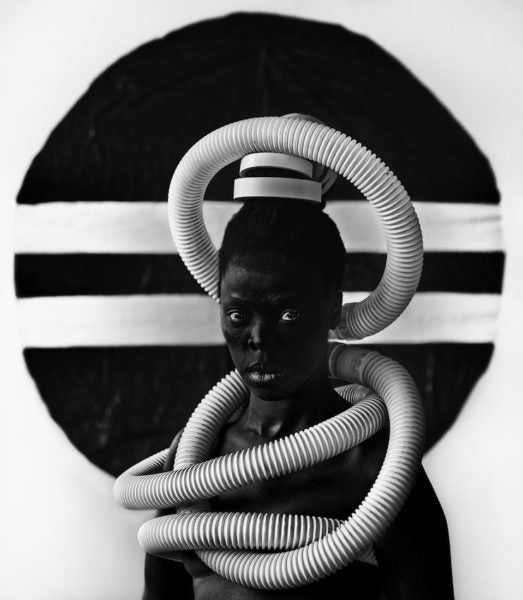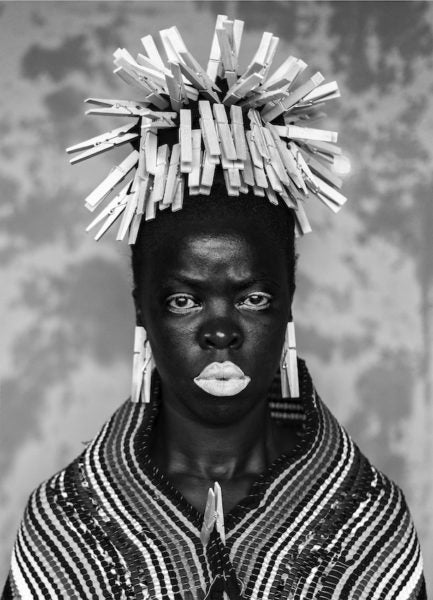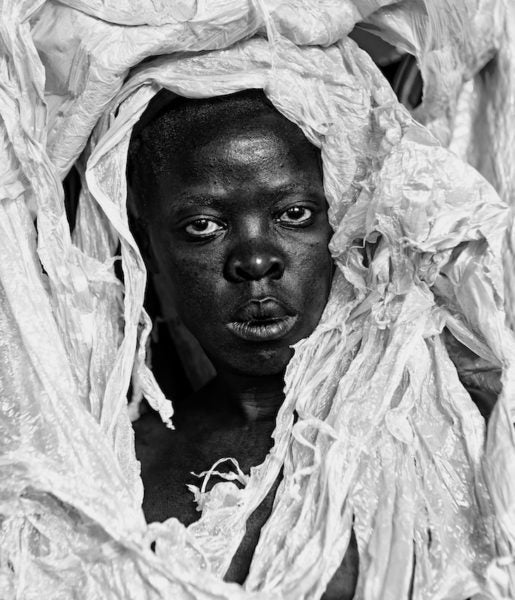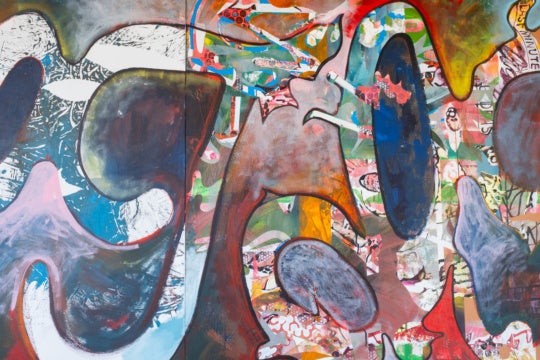
“It’s not like, ‘Oh, we wanted to capture beautiful images.’ It’s not about beauty,” Zanele Muholi told an attentive crowd gathered in a half-moon around them. (Muholi uses the pronouns they and them.) The photographer stood on a small white stool as they explained the process behind the photographs on view in “Somnyama Ngonyama, Hail the Dark Lioness” at Spelman College Museum of Fine Art, the exhibition’s American premiere. By the time Muholi began their talk, I had already seen the show, and I did find beauty in it—but it wasn’t a beauty solely linked to the artwork’s aesthetic value. I recognized Muholi’s brazen gaze at the camera’s lens. I could tell they had something to say.
Born in Umlazi, South Africa in 1972, Muholi is a visual activist and photographer whose work documents LGBTI people and sheds light on social and political issues in South Africa. Muholi’s work has centered the queer community for years. Their first solo show, “Visual Sexuality” (2004), addressed themes of gender and sexuality, and they co-founded the Forum for the Empowerment of Women, a Johannesburg-based LGBTI rights organization, among other advocacy initiatives. Muholi has taken self-portraits as part of their previous projects, but this time dozens of images of the artist line the walls of the museum’s galleries, often staring back at the viewer unabashedly and with fierce certainty.

All the photos in “Somnyama Ngonyama” are black-and-white. Muholi enhanced the images’ contrast in post-production so that their eyes stand out against their skin like headlights on a pitch-black road. From 2014 through 2017, Muholi took the photos on view in different cities around the world, often using found objects as wearable ornaments or props. Torn plastic encircles their face like a lion’s mane in Kwanele, Parktown (2016), and vacuum hoses adorn their body like oversized jewelry in Sebenzile, Parktown (2016). While such moments of material ingenuity appear throughout the exhibition, I would have never recognized some of them had Muholi not pointed them out. They wear toothpaste as lipstick in Bester I, Mayotte (2015), and travel pillows wrap around their neck like boa constrictors in Somnyama III, Paris (2014). Counterintuitive materials such as toilet tissue and garbage bags help create the graphic background in Sebenzile, Parktown (2016).
The photos are striking, but not just because of their jarring contrast or Muholi’s use of unexpected materials. Perhaps I am drawn to the photo Bester I, Mayotte (2015) by its composition, by the clothespins Muholi wears in their hair and as earrings, by their world-weary gaze, or by the visual pleasure of their smooth skin against the patterned backdrop. Muholi stands firmly in the center of the photo, bust-like in their self-assured posture. Through whatever character Muholi takes on—in the case of Bester I, Mayotte (2015), they portray an imaginary version of their mother, who was a domestic worker—Muholi claims their rightful place in the annals of history, in the photographic record, and on the walls of the Spelman College Museum of Fine Art.

Muholi is the only person pictured in the entire exhibition, but “Somnyama Ngonyama” addresses more than their experiences as an individual. Wall text renders a quote of Muholi’s in stark white vinyl letters against the black wall that greets viewers as they enter the main exhibition space: “I’m reclaiming my blackness, which I feel is continuously performed by the privileged other. My reality is that I do not mimic being black; it is my skin, and the experience of being black is deeply entrenched in me. Just like our ancestors, we live as black people 365 days a year, and we should speak without fear.”
In “Somnyama Ngonyama,” Muholi asserts the black narrator’s authority over black narratives—they choose the location, take the photos, and select the found objects that are transformed to tell stories of the underrepresented. Yes, the photos are beautiful in that they are masterful and original, but they are also surprisingly subversive. Despite their beauty, these images don’t reinforce dominant power structures but instead challenge them. Muholi’s almost alchemical process of repurposing everyday objects—gloves, a wooden stool, artificial chains used as Halloween decorations—into tools of storytelling and resistance remarkably evokes a spirit of blackness.

The story behind certain photos is not always easy to place, as with the reference to the Marikana massacre in South Africa in Thulani II, Parktown (2015)—which shows an image of Muholi shirtless portraying a miner—but wall text helps to illuminate relevant details that may not be explicit in the images. “Enough villages under sand. Enough tear gas in the eyes of protesters. Enough extinct species,” reads a portion of text installed beneath a particularly heavy-handed photo of Muholi holding up an image of two rhinos as if it were protest signage. In the exhibition, Muholi touches on environmental abuse and degradation, human rights, the invisibility of the legacy of people of the African diaspora in Japan, the plight of domestic workers, and personal health struggles. These issues are all connected, Muholi suggests, and worthy of documenting. In the end, there is no mystery in the message: here, the black body speaks in the declarative. It says, “I own my identity and story, and I will tell them my way.”
As I move from photo to photo in the exhibition space, I follow Muholi’s journey from New York to Sardinia to Oslo to Charlottesville. I imagine Muholi dressed in their found objects, setting their camera’s timer and shuffling to position to take the perfect photograph. I am entranced and invigorated by the thought of Muholi affirming their presence in places where they are unwanted, borrowing from each setting and yet creating something new out of it. In the photos, Muholi is purposefully visible, reclaiming power and carving out room for themselves.

In “Somnyama Ngonyama: Hail the Dark Lioness,” Muholi continues their work of memorializing and spotlighting people and stories which may be dismissed otherwise. Fortunately for viewers, this visual activism takes the form of beautifully composed, thoughtful photographs. Muholi focuses their attention and lens on the margins of society, then brings those margins into sharper focus. We hail the dark lioness not because she is some fearsome sovereign, but because she is fierce, courageous, and ever-present, despite the absence darkness may signify for those who don’t see its richness.
“Zanele Muholi: Somnyama Ngonyama, Hail the Dark Lioness” is an exhibition curated by Renee Mussai of Autograph, London, and presented by the Spelman College Museum of Fine Art, where it remains on view through December 8, 2018.




